belt Lancia Thesis 2007 Owner handbook (in English)
[x] Cancel search | Manufacturer: LANCIA, Model Year: 2007, Model line: Thesis, Model: Lancia Thesis 2007Pages: 386, PDF Size: 8.69 MB
Page 86 of 386
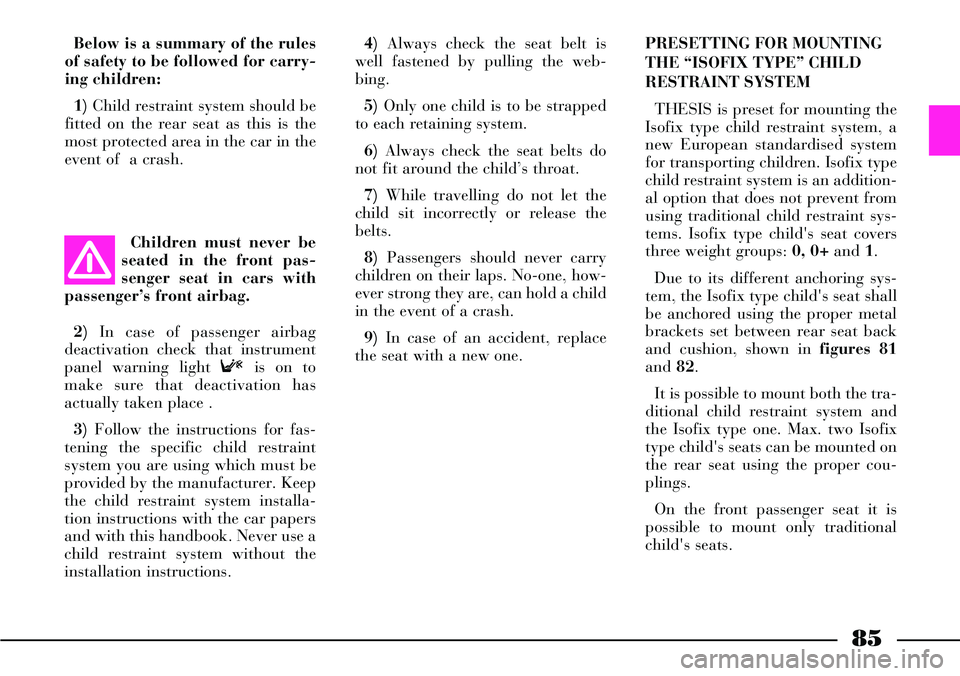
85
Below is a summary of the rules
of safety to be followed for carry-
ing children:
1) Child restraint system should be
fitted on the rear seat as this is the
most protected area in the car in the
event of a crash.4) Always check the seat belt is
well fastened by pulling the web-
bing.
5) Only one child is to be strapped
to each retaining system.
6) Always check the seat belts do
not fit around the child’s throat.
7) While travelling do not let the
child sit incorrectly or release the
belts.
8) Passengers should never carry
children on their laps. No-one, how-
ever strong they are, can hold a child
in the event of a crash.
9) In case of an accident, replace
the seat with a new one.PRESETTING FOR MOUNTING
THE “ISOFIX TYPE” CHILD
RESTRAINT SYSTEM
THESIS is preset for mounting the
Isofix type child restraint system, a
new European standardised system
for transporting children. Isofix type
child restraint system is an addition-
al option that does not prevent from
using traditional child restraint sys-
tems. Isofix type child's seat covers
three weight groups: 0, 0+and 1.
Due to its different anchoring sys-
tem, the Isofix type child's seat shall
be anchored using the proper metal
brackets set between rear seat back
and cushion, shown in figures 81
and82.
It is possible to mount both the tra-
ditional child restraint system and
the Isofix type one. Max. two Isofix
type child's seats can be mounted on
the rear seat using the proper cou-
plings.
On the front passenger seat it is
possible to mount only traditional
child's seats. Children must never be
seated in the front pas-
senger seat in cars with
passenger’s front airbag.
2) In case of passenger airbag
deactivation check that instrument
panel warning light Fis on to
make sure that deactivation has
actually taken place .
3) Follow the instructions for fas-
tening the specific child restraint
system you are using which must be
provided by the manufacturer. Keep
the child restraint system installa-
tion instructions with the car papers
and with this handbook. Never use a
child restraint system without the
installation instructions.
Page 87 of 386

86
Only use Isofix type child restraint
systems specifically designed, tested
and approved for this car.Mount the child
restraint system only with
the car stationary. The
Isofix child restraint system is
properly anchored to the mount-
ing brackets when clicks are
heard. In any case, keep to the
installation instructions that
must be provided by the child
restraint system’s Manufacturer.Mounting the ISOFIX TYPE
child restraint system
Groups 0 and 0+
For children included in this
weight group (up to 13 kg) the
restraint system faces back and the
child is held by the restraint system
belts D(fig. 83).
fig. 81
L0A0271b
fig. 82
L0A0270b
fig. 83
L0A0254b
Page 89 of 386

88
FRONT AND SIDE
AIRBAGS
The car is equipped with front
(Multistage) airbags for the driver
(fig. 86) and passenger B(fig. 87),
front side bags C (fig. 88), window
bags D(fig. 89) and (where provid-
ed) rear side bags E(fig. 90).
“SMART BAG” SYSTEM
(FRONT MULTISTAGE AIRBAGS)
Description and operation
The front air bag (driver and pas-
senger) is a safety device which
comes into action in the event of a
front/angled impact.
fig. 86
L0A0067b
For proper mounting, proceed as
follows:
– remove the upper tether on the
back of the child's restraint system;
– remove the black plate on the
child's seat back and loosen the
three knob screws completely;
– check whether the release lever B
(fig. 85) is at rest position (inward);
– identify the brackets A(fig. 85)
and mount the child restraint system
with the retainers C(fig. 85) aligned
to the brackets;
– push the child restraint system
until hearing the locking clicks;
– check for proper locking by mov-
ing the child's seat with force: the
built-in safety mechanism actually
inhibit improper coupling with just
one coupling locked.
With this configuration, the child is
secured also by the car seat belts
(fig. 85).
To apply car seat belts to child's
seat, refer to the child's seat hand-
book.It consists of an instantly inflatable
bag housed in a special compart-
ment located:
– in the centre of the steering wheel
on the driver’s side A (fig. 86);
– in the dashboard on the passen-
ger’s side (larger bag) B(fig. 87).
fig. 87
L0A0068b
fig. 88
L0A0069b
Page 90 of 386
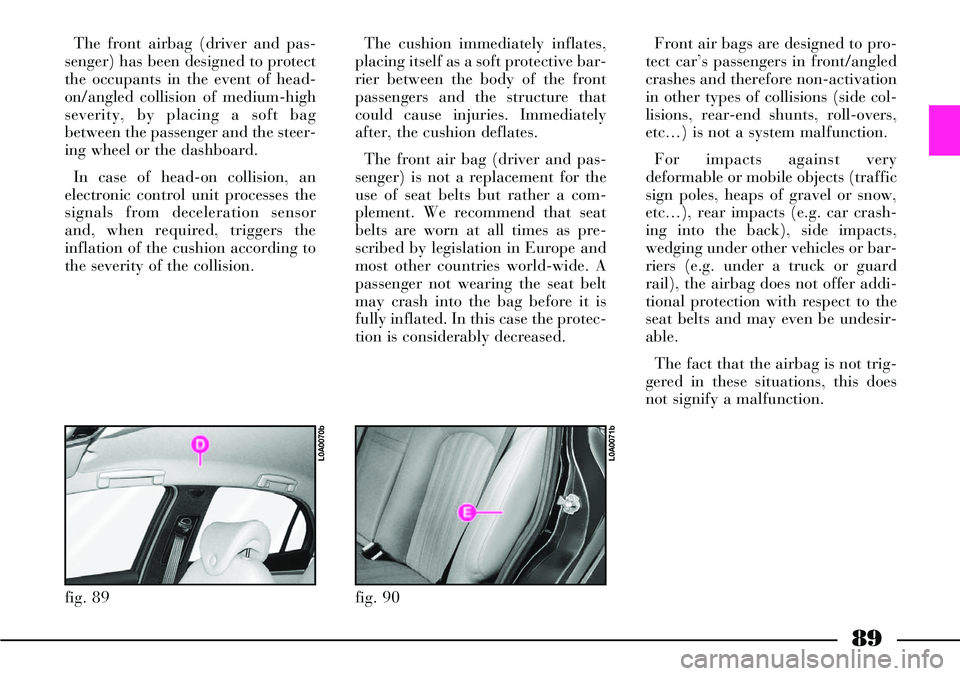
89
The front airbag (driver and pas-
senger) has been designed to protect
the occupants in the event of head-
on/angled collision of medium-high
severity, by placing a soft bag
between the passenger and the steer-
ing wheel or the dashboard.
In case of head-on collision, an
electronic control unit processes the
signals from deceleration sensor
and, when required, triggers the
inflation of the cushion according to
the severity of the collision.
fig. 89
L0A0070b
The cushion immediately inflates,
placing itself as a soft protective bar-
rier between the body of the front
passengers and the structure that
could cause injuries. Immediately
after, the cushion deflates.
The front air bag (driver and pas-
senger) is not a replacement for the
use of seat belts but rather a com-
plement. We recommend that seat
belts are worn at all times as pre-
scribed by legislation in Europe and
most other countries world-wide. A
passenger not wearing the seat belt
may crash into the bag before it is
fully inflated. In this case the protec-
tion is considerably decreased.
fig. 90
L0A0071b
Front air bags are designed to pro-
tect car’s passengers in front/angled
crashes and therefore non-activation
in other types of collisions (side col-
lisions, rear-end shunts, roll-overs,
etc…) is not a system malfunction.
For impacts against very
deformable or mobile objects (traffic
sign poles, heaps of gravel or snow,
etc…), rear impacts (e.g. car crash-
ing into the back), side impacts,
wedging under other vehicles or bar-
riers (e.g. under a truck or guard
rail), the airbag does not offer addi-
tional protection with respect to the
seat belts and may even be undesir-
able.
The fact that the airbag is not trig-
gered in these situations, this does
not signify a malfunction.
Page 91 of 386
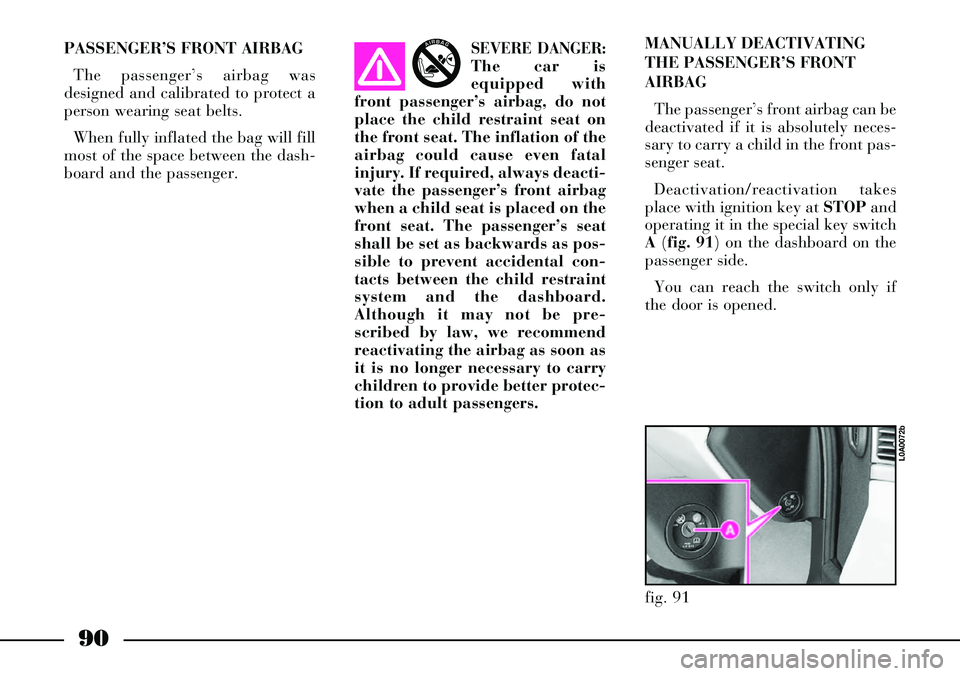
90
SEVERE DANGER:
The car is
equipped with
front passenger’s airbag, do not
place the child restraint seat on
the front seat. The inflation of the
airbag could cause even fatal
injury. If required, always deacti-
vate the passenger’s front airbag
when a child seat is placed on the
front seat. The passenger’s seat
shall be set as backwards as pos-
sible to prevent accidental con-
tacts between the child restraint
system and the dashboard.
Although it may not be pre-
scribed by law, we recommend
reactivating the airbag as soon as
it is no longer necessary to carry
children to provide better protec-
tion to adult passengers.
AIRBAGPASSENGER’S FRONT AIRBAG
The passenger’s airbag was
designed and calibrated to protect a
person wearing seat belts.
When fully inflated the bag will fill
most of the space between the dash-
board and the passenger.MANUALLY DEACTIVATING
THE PASSENGER’S FRONT
AIRBAG
The passenger’s front airbag can be
deactivated if it is absolutely neces-
sary to carry a child in the front pas-
senger seat.
Deactivation/reactivation takes
place with ignition key at STOPand
operating it in the special key switch
A(fig. 91) on the dashboard on the
passenger side.
You can reach the switch only if
the door is opened.
fig. 91
L0A0072b
Page 93 of 386
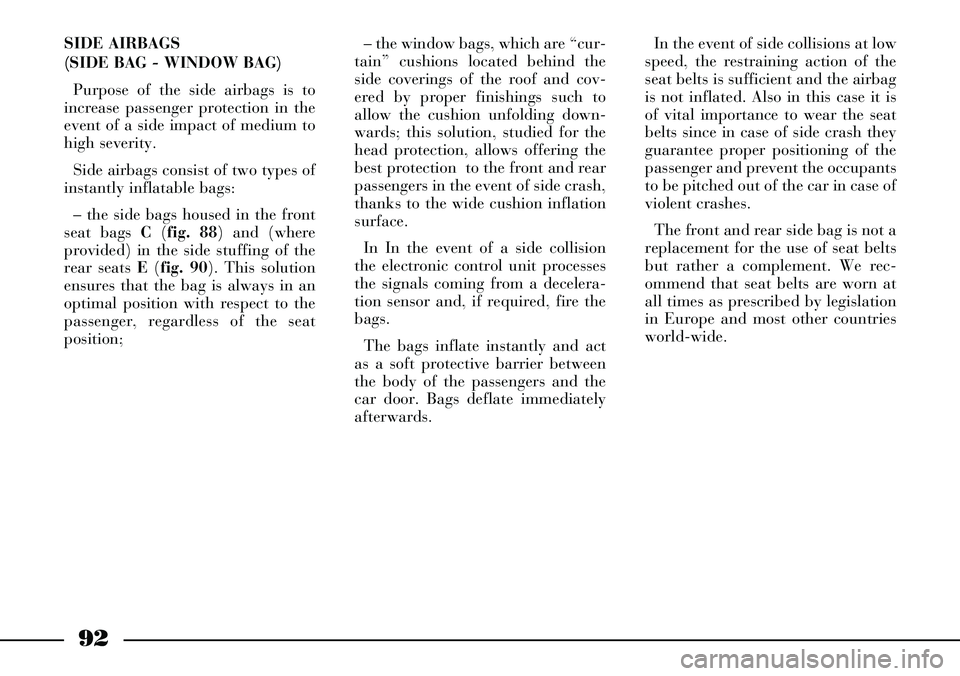
In the event of side collisions at low
speed, the restraining action of the
seat belts is sufficient and the airbag
is not inflated. Also in this case it is
of vital importance to wear the seat
belts since in case of side crash they
guarantee proper positioning of the
passenger and prevent the occupants
to be pitched out of the car in case of
violent crashes.
The front and rear side bag is not a
replacement for the use of seat belts
but rather a complement. We rec-
ommend that seat belts are worn at
all times as prescribed by legislation
in Europe and most other countries
world-wide.
92
SIDE AIRBAGS
(SIDE BAG - WINDOW BAG)
Purpose of the side airbags is to
increase passenger protection in the
event of a side impact of medium to
high severity.
Side airbags consist of two types of
instantly inflatable bags:
– the side bags housed in the front
seat bags C (fig. 88) and (where
provided) in the side stuffing of the
rear seats E (fig. 90). This solution
ensures that the bag is always in an
optimal position with respect to the
passenger, regardless of the seat
position;– the window bags, which are “cur-
tain” cushions located behind the
side coverings of the roof and cov-
ered by proper finishings such to
allow the cushion unfolding down-
wards; this solution, studied for the
head protection, allows offering the
best protection to the front and rear
passengers in the event of side crash,
thanks to the wide cushion inflation
surface.
In In the event of a side collision
the electronic control unit processes
the signals coming from a decelera-
tion sensor and, if required, fire the
bags.
The bags inflate instantly and act
as a soft protective barrier between
the body of the passengers and the
car door. Bags deflate immediately
afterwards.
Page 94 of 386

IMPORTANT If the ¬warning
light does not turn on when turning
the ignition key to MARor if it stays
on when travelling, (together with
message on display) this could indi-
cate a failure in safety retaining sys-
tems; under this condition air bags
or pretensioners could not trigger in
the event of collision or, in a restrict-
ed number of cases, they could trig-
ger accidentally. Stop the car and
contact Lancia Dealershipto have
the system checked immediately.
The air bag system has a validity of
14 years as concerns the pyrotechnic
charge and 10 years as concerns the
coil contact (see the plate on the front
let door). As these dates approach, con-
tact Lancia Dealershipto have them
replaced.
IMPORTANTAfter an accident
which triggered the airbags, go to a
Lancia Dealershipto have the
entire safety system, the electronic
control unit, the seat belts and the
pretensioners replaced and to have
the electrical system checked. Never lean head, arms
and elbows out of the
window.Operation of the front bags is not
disabled by the passenger’s front
airbag and rear side bag deactiva-
tion switch.
IMPORTANTIn the event of side
crash, you can obtain the best pro-
tection by the system keeping a cor-
rect position on the seat, allowing
thus a correct window bag unfold-
ing.IMPORTANTThe front airbags
and/or front and rear side bags can
be triggered if the car is involved in
hard impacts or collisions in the area
of the underbody, such as for exam-
ple violent impacts against steps,
kerbs or projecting objects fixed to
the ground or if the car falls into
large pot-holes or dips in the road
surface.
IMPORTANTWhen the airbag is
fired it emits a small amount of
powder and smoke. This is not
harmful and does not indicate the
beginning of a fire. Furthermore the
surface of the inflated bag and the
passenger compartment may be cov-
ered with powder residues. This
powder may irritate skin and eyes.
In the event of exposure, wash with
mild soap and water.
93
Never rest head, arms
and elbows on the door,
on the windows and in the
window bag area to prevent pos-
sible injuries during the inflation
phase.
Page 97 of 386

96
Do not hook rigid
objects to the coat hooks
and to the support han-
dles.The airbag does not
replace seat belts but
rather increases their
effectiveness. Furthermore, the
airbag is not fired in the event of
low speed front collisions, rear-
end shunts and roll-overs. In
these cases, the passengers are
only protected by the seat belts
which for this reason must
always be fastened. When the ignition key is
turned to MAR (passenger
front airbag and rear side
bag deactivation switch at ON),
warning lights F F
and
Àwill
come on flashing for a few sec-
onds to remind the driver that
passenger front airbag and rear
side bags will be fired in the
event of a crash. Warning lights
should go out immediately after-
wards.The airbag is set to be
fired in the event of colli-
sions which are greater
than the pretensioner settings.
Consequently, for collisions in
the bracket between the two
thresholds, it is normal for only
the pretensioners to be fired.
Do not wash the seat
back rest with pres-
surised water or steam
(by hand or at automatic seat
washing stations).
Page 118 of 386
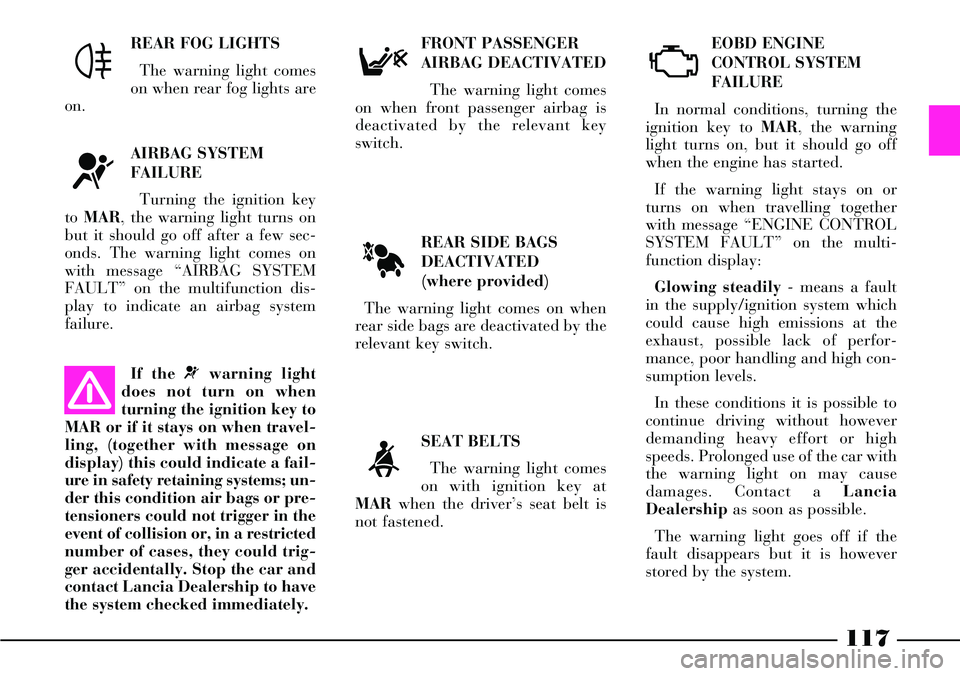
117
REAR SIDE BAGS
DEACTIVATED
(where provided)
The warning light comes on when
rear side bags are deactivated by the
relevant key switch.EOBD ENGINE
CONTROL SYSTEM
FAILURE
In normal conditions, turning the
ignition key to MAR, the warning
light turns on, but it should go off
when the engine has started.
If the warning light stays on or
turns on when travelling together
with message “ENGINE CONTROL
SYSTEM FAULT” on the multi-
function display:
Glowing steadily- means a fault
in the supply/ignition system which
could cause high emissions at the
exhaust, possible lack of perfor-
mance, poor handling and high con-
sumption levels.
In these conditions it is possible to
continue driving without however
demanding heavy effort or high
speeds. Prolonged use of the car with
the warning light on may cause
damages. Contact a Lancia
Dealershipas soon as possible.
The warning light goes off if the
fault disappears but it is however
stored by the system. FRONT PASSENGER
AIRBAG DEACTIVATED
The warning light comes
on when front passenger airbag is
deactivated by the relevant key
switch.
SEAT BELTS
The warning light comes
on with ignition key at
MARwhen the driver’s seat belt is
not fastened.
F
<
U
À
REAR FOG LIGHTS
The warning light comes
on when rear fog lights are
on.
AIRBAG SYSTEM
FAILURE
Turning the ignition key
to MAR, the warning light turns on
but it should go off after a few sec-
onds. The warning light comes on
with message “AIRBAG SYSTEM
FAULT” on the multifunction dis-
play to indicate an airbag system
failure.
4
¬
If the ¬warning light
does not turn on when
turning the ignition key to
MAR or if it stays on when travel-
ling, (together with message on
display) this could indicate a fail-
ure in safety retaining systems; un-
der this condition air bags or pre-
tensioners could not trigger in the
event of collision or, in a restricted
number of cases, they could trig-
ger accidentally. Stop the car and
contact Lancia Dealership to have
the system checked immediately.
Page 233 of 386

232
The mobile net can be secured to
one of the two positions provided in
the front part of the boot (fig. 197-
198), by hooking it onto seats Aand
B(fig. 199).To secure the net, insert hooks A
(fig. 200) in seats Bthen push
downwards.
The net can be unhooked by slip-
ping it off upwards, by pressing
down button Con the attachment.ANCHORING THE LOAD
The loads can be secured with belts
(not provided), attached to the spe-
cific rings (fig. 201-202) in the boot
corners.
fig. 197
L0A0046b
fig. 198
L0A0047b
fig. 199
L0A0099b
fig. 200
L0A0048b
fig. 201
L0A0219b